Tideway Central – Main Tunnel Secondary Lining (2021)
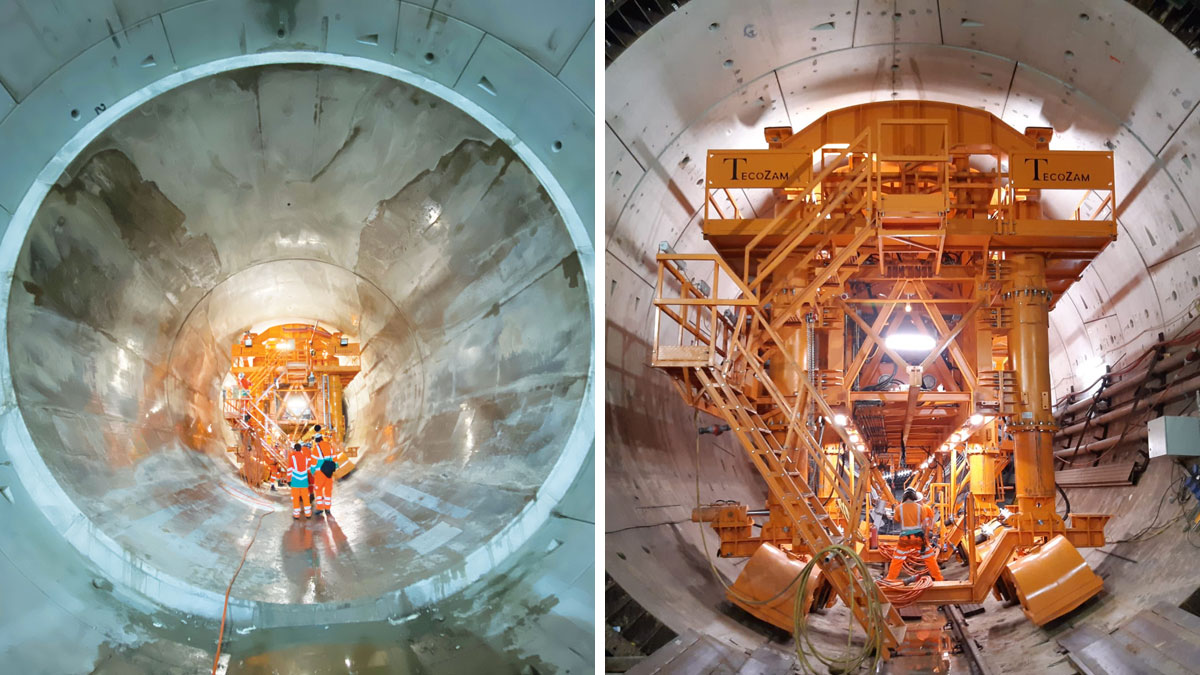
Main tunnel secondary lining shutter - Courtesy of Tideway
In the heart of London, the largest project in the UK water industry is underway. Tideway is a new combined storage transfer system, commissioned to provide London’s sewage network with additional capacity and prevent pollution of the River Thames. The colossal scheme consists of a 25km TBM bored tunnel with numerous shafts, associated outfalls and surface structures along its route. This paper provides an introduction to the Tideway Project, with a focus on the Central Section’s main tunnel and the value engineering of the cast in place secondary lining.
History
London’s current sewer system is over 150 years old and has reached its capacity, with combined sewer outflow (CSO) discharges into the River Thames becoming a frequent event. Since the sewage system was designed by Joseph Bazalgette in the 1860s, London’s population has more than doubled and the area of permeable surfaces decreased. Consequently, wastewater and surface water run-off has increased dramatically, and the current sewer system is unable to cope. In fact, just 2mm of rainfall can result in raw sewage being discharged into the River Thames via CSOs.
In an effort to upgrade the sewage network, and to ensure the quality of the River Thames complies with the European Urban Wastewater Treatment Directive (EU 1991), the Tideway project was commissioned.
Tideway Central Contract
AECOM was appointed by the Ferrovial Construction Laing O’Rourke Joint Venture (FLO) as the lead designer of the central section of Thames Tideway Tunnel project. The contract for the central section involved the design of nine shafts along with associated outfalls and surface structures along the route of the 7.8m ID TBM bored tunnel, approximately 13 km long.
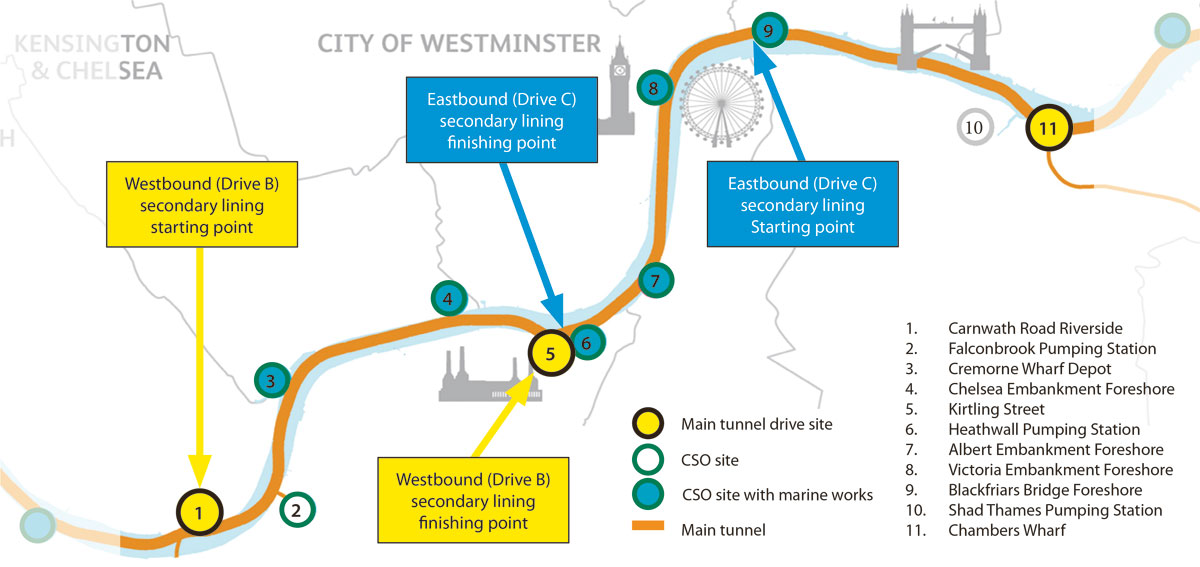
Main Tunnel Central Section – Courtesy of Tideway
The main tunnel has been constructed in two drives; westbound from the Kirtling Street shaft to the Carnwarth Road shaft (Tunnel B) with an approximate length 4.9km, and eastbound from the Kirtling Street Shaft to the Chambers Wharf Shaft (Tunnel C) with an approximate length of 7.7km. The Carnwath Road and Chambers Wharf shafts are part of the West and East contracts respectively and will act as reception shafts for the tunnels of the central section. The launch of the TBMs for the central section towards east and west took place from the Kirtling Street Shaft inside two SCL adits due to space constraints in the shaft.
Geology
The main tunnel of Tideway Central contract lies within the geological province of the London basin. The geological stratigraphy of the Central Section in the London Basin consists of Made Ground, Alluvium, River Terrace Deposits, London Clay Formation, Harwich Formation, Lambeth Group, Thanet Sand Formation and Chalk.
Over the course of the central section, from the Carnwarth Road site to the Chambers Wharf site, the main tunnel encounters major changes in the geological stratigraphy.
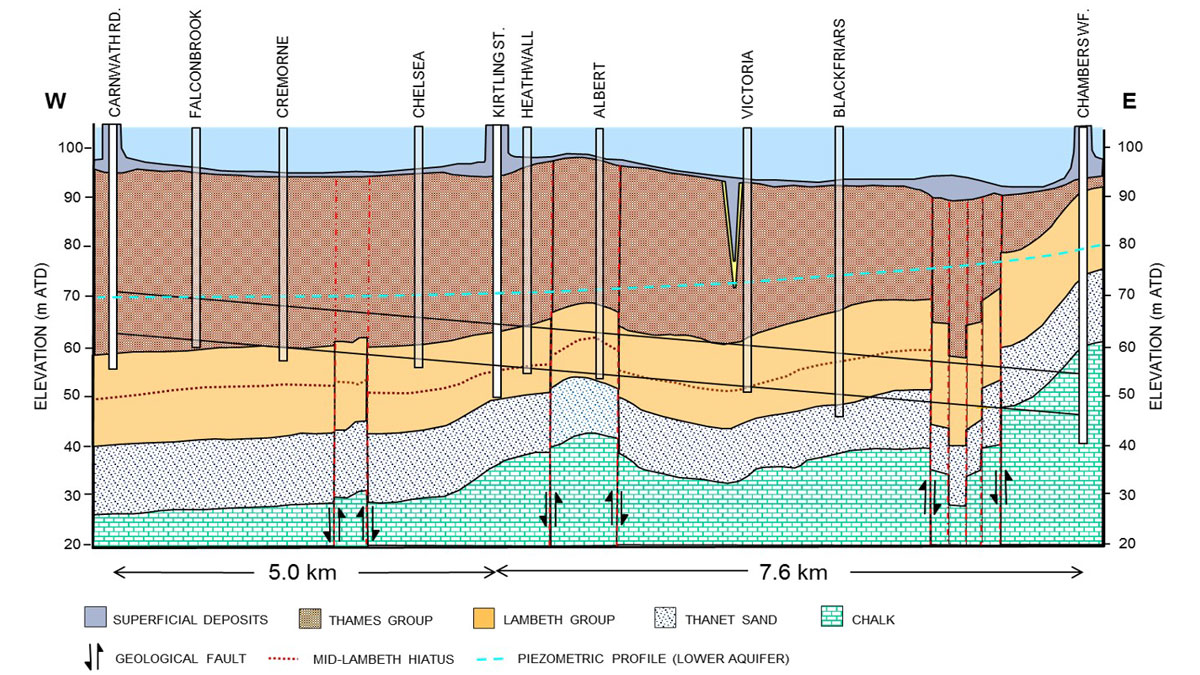
Geology for Central Contract Tunnel – Courtesy of Tideway
Main tunnel performance requirements
Tideway’s design specification for tunnels, shafts and junctions states that the main tunnel shall be provided with a primary and secondary lining to ensure that, throughout the required 120 year design life of the works, the minimum performance requirements are met. The minimum performance requirements for the completed tunnel include:
- Withstand all reasonably foreseeable external loads.
- Withstand internal hydraulic pressures.
- Meet water tightness criteria.
- Meet durability criteria.
- Prevent excessive ground movements.
- Prevent aquifer contamination.
Main tunnel secondary lining
The main tunnel was constructed in two passes. The first pass was a 7.8m ID TBM bored primary precast concrete segmental lining and the second pass a 7.3m ID cast-in-place secondary lining.
The primary lining has been designed to fulfil the watertightness criteria for the main tunnel alone. The secondary lining is not simply an additional layer of water proofing but plays an essential role in ensuring the durability of the main tunnel over the 120-year design life is accomplished. It achieves this through protecting the primary lining from abrasion and chemical attack from the effluent/storm water within the tunnel.
The secondary lining is formed of steel fibre reinforced concrete (SFRC) to aid its ability to comply with the stringent durability requirements. Additional advantages of using SFRC includes significantly improved construction costs, time, and reduced carbon dioxide emissions.
The primary lining has been designed to be capable of carrying the external and internal design loads of the main tunnel without support from the secondary lining. Nonetheless, the secondary lining will attract a share of these loads and has been designed on this basis.
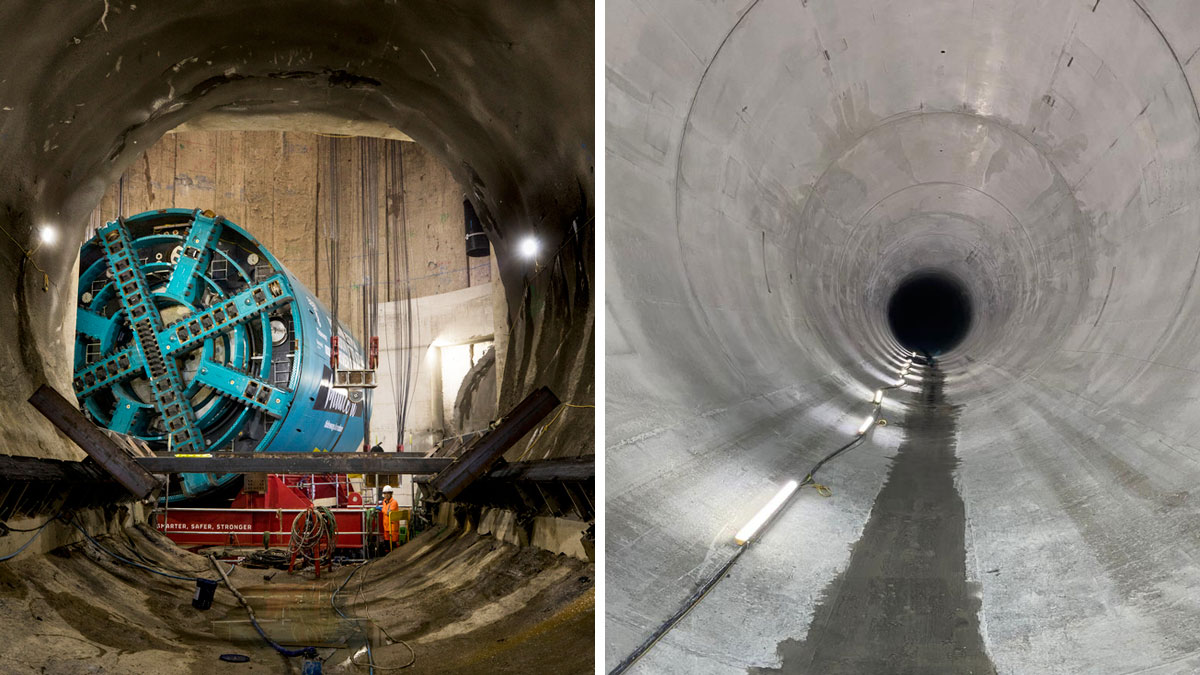
(left) main tunnel TBM and (right) main tunnel secondary lining – Courtesy of Tideway
Shutter and striking time
The SFRC secondary lining is cast in place using a full circular shutter, eliminating the need for radial construction joints. A typical shutter length of 12.6m, travelling along the tunnels, was selected to tie into the length of the primary lining segments; Seven segmental lining rings of 1.8m length.
In depth analysis of the early age strength development of the concrete led to a reduction in the required striking strength of the secondary lining (6.5 MPa cylinder strength). Extensive testing was undertaken to ensure a robust concrete mix is achieved that can deliver the strength requirements. Through reducing the striking strength requirement of the secondary lining, the time taken from pouring the concrete to removing the shutter has been greatly reduced, improving the production rate of construction.
Design development
The design of the main tunnel was developed through undertaking several different design options. The initial design for the main tunnel was a two-pass tunnel lining design (2016), which consisted of a primary and secondary tunnel lining. The combination of the two-pass tunnel lining was designed to provide the overall main tunnel minimum performance requirements, with each individual lining meeting a proportion of the structural and durability criteria.
Subsequently, a primary tunnel lining reassessment (2017) was carried out with the cast in place steel fibre reinforced concrete (SFRC) secondary lining designed (2017) to meet the durability criteria, where the segmental primary lining was re-designed to meet the structural and water tightness minimum performance requirements for the main tunnel alone.
Through carrying out in-depth analyses for the primary and secondary tunnel lining options, a more extensive understanding of the geological medium, ground parameters and soil-structure interaction was established. Based on the knowledge gained through design development and collaboration with FLO JV and Tideway, AECOM was able to achieve several optimisations to the previous cast in place secondary lining design (2017).
Optimisations made to the previous cast in place secondary lining design (2017) included decreasing the thickness of the secondary lining from 300mm to 250mm and a reduction in the performance strength requirements of the SFRC mix. Through the value engineering of the main tunnel secondary lining, substantial concrete savings have been achieved which will alleviate the environmental impact of its construction and decrease the project’s overall cost.
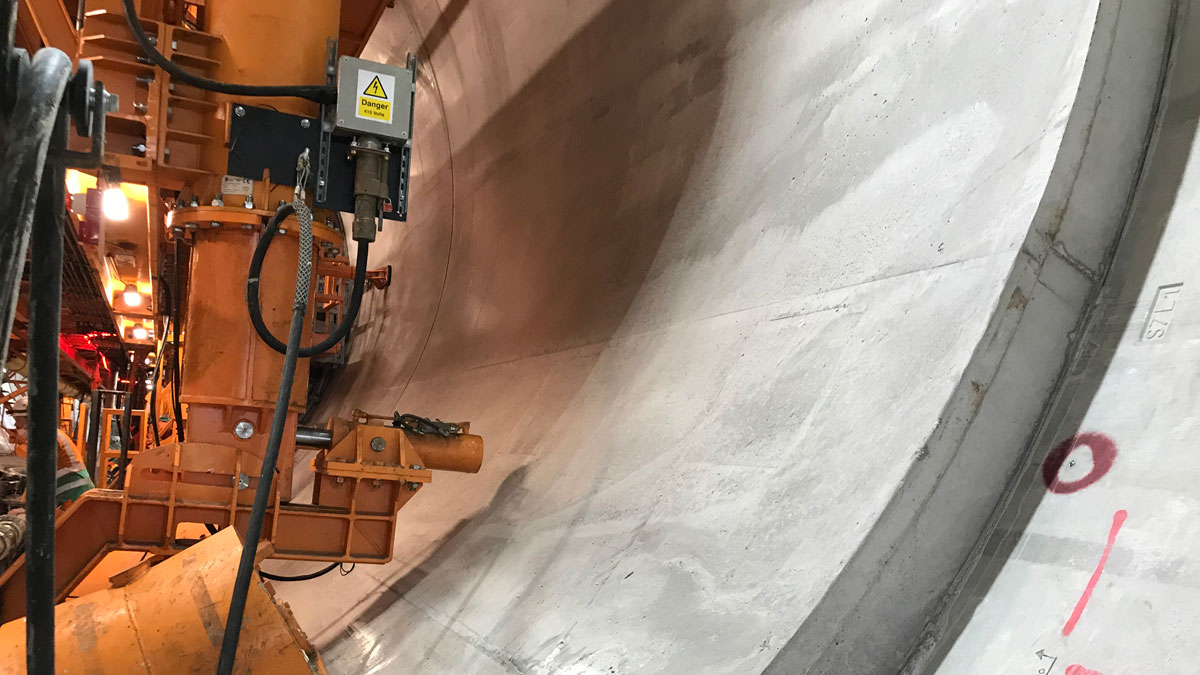
Main tunnel secondary lining and precast segmental primary lining behind – Courtesy of AECOM
Tideway Central: Main Tunnel Secondary Lining: Supply chain
- Client: Tideway
- Project manager & principal designer: Tideway (Jacobs)
- Principal contractor & lead designer: FLO JV
- Main designer (permanent works): AECOM
- Durability consultant: OTB Concrete
- CAT III checker: Arup Atkins Joint Venture
- Secondary lining formwork: TECOZAM
- Precast concrete segmental lining: Pacadar
- TBM: NFM Technologies
- Cast in situ concrete: Hanson
- Steel: Express Reinforcement
Numerical modelling of the secondary lining
As a result of the complex ground conditions and significant size of the tunnel, the geotechnical finite element software PLAXIS 2D was deemed necessary to derive an accurate representation of the soil-structure interaction.
To ensure design accurately represented the range of geological strata present, the central section alignment was split into several sections at locations of anticipated geological change. Accordingly, the critical tunnel sections were modelled in PLAXIS 2D finite element analyses.
Extensive parametric studies for different ground parameters were carried out using the soil-structure interaction model PLAXIS 2D to identify the worst design scenarios for the tunnel lining. In addition to this, different ground relaxation factors based on the Panet (1979) solution were considered to evaluate the different ground conditions that the tunnel will encounter along its route. Ground parameters considered include:
- Overburden pressure.
- Ground strength (upper and lower bound strength parameters for the each soil formations).
- Ground stiffness of the soil for different strain levels (over consolidated clays are known to exhibit strongly nonlinear strain stiffness behaviour with high stiffness at very small strains, decreasing with increasing strain).
- Variation of at rest earth pressure coefficient (K0min and K0max).
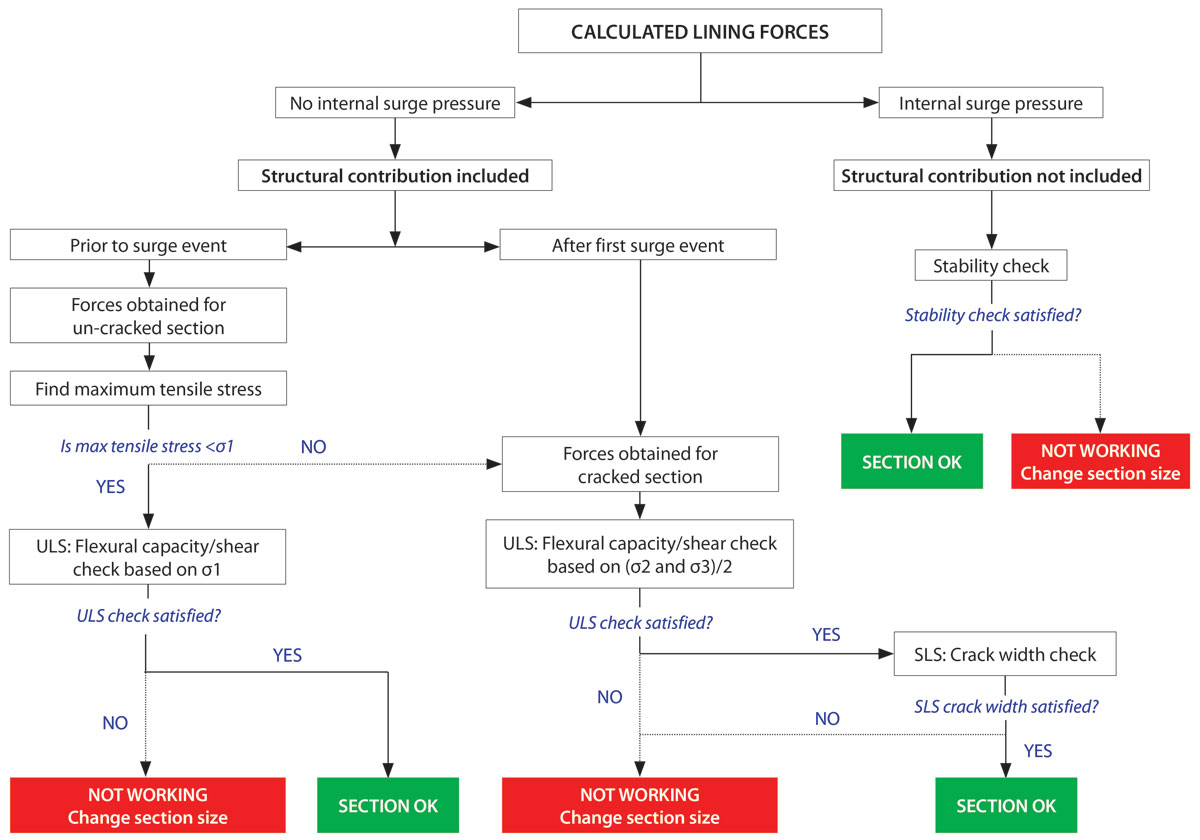
Design procedure flowchart
Structural analysis of main tunnel secondary lining
There are two principal scenarios for the main tunnel secondary lining:
- No internal surge pressure.
- Prior to a surge event (uncracked section).
- After 1st surge event (cracked section).
- Internal surge pressure.
For the design scenario without internal surge pressure, all secondary lining should be in compression with limited bending moment. For the design scenario with internal load from a surge event, it is expected that tensile stress will occur in the secondary lining which cannot be resisted solely by the steel fibre reinforced concrete and thus, the lining will no longer contribute as a structural element.
Following this major distinction between the possible scenarios, the design route was split into two branches. Subject to the presence of internal surge pressure or not, different design procedures were required.
An additional investigation was carried out to examine the extent of load sharing that the optimised secondary lining would participate in. To do this the hoop force (Nt) for the primary and secondary lining was compared for each chainage, considering each construction stage and the different variables discussed previously in this paper. The range of loading experienced by the secondary lining is shown in the following table. The results indicate that the secondary lining will experience up to 30% of load sharing with the primary lining, dependent on the construction stage and variables considered.

Range of loading experienced by the secondary lining
Conclusion
The optimisations achieved by Tideway, AECOM and FLO JV have resulted in significant cost savings for the project and majorly increased the efficiency of its construction. At the time of writing (June 2021) approximately 3.15 km of Tunnel B and 1.5 km of Tunnel C has been cast.





